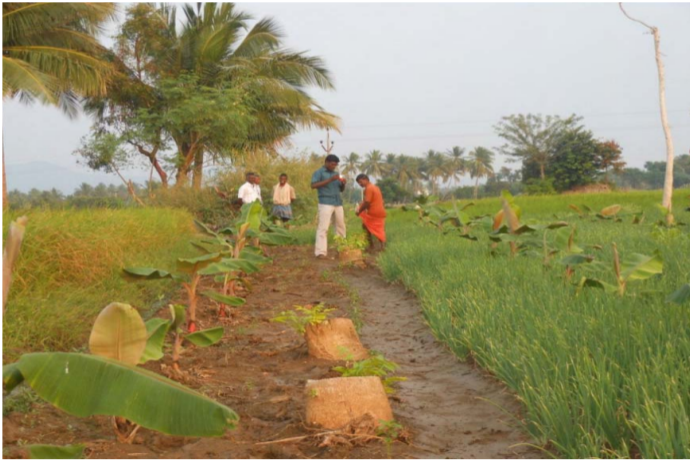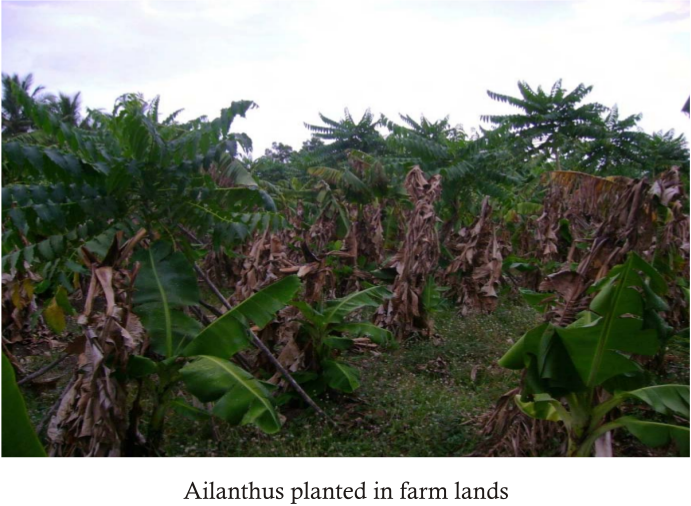Ailanthus excelsa
Ailanthus excelsa
Site factors
Ailanthus excelsa. Roxb is one of the medium sized, fast growing tree species within the genus Ailanthus belonging to the family Simaroubaceae. Arid to semi arid region Ailanthus is often found below 1,200 m MSL with a mean annual rainfall of about 500-1900 mm. It grows in broad range of soil types including sandy soils and adapts to drought stress and tolerates a dry season of 4-6 months. In Tamilnadu it is distributed in four agroclimatic zones namely Western zone, North western zone, Cauvery delta zone and Southern zone.
Planting stock
Seeds of Ailanthus excelsa collected in selected Candidate Plus Trees (CPT’s) from different agro climatic zones having 10-15% improvement in growth when compare to other local seed sources. The collected seed sources are multiplied and supplied based on prior request. The seeds collected by IFGTB are being sold at the cost Rs.1000/Kg. From one kg of seeds about 4000 healthy seedlings can be obtained.
Seed collection, processing and Nursery techniques
Flowers appear February – March in Central India and in April in north India but in South India December – February. The fruits ripen March to May. Ripe fruits are collected off the trees before these are blown away by the wind. Seeds are dried in the shade. Seed viability is very short and cannot be stored for the next year. Seed weight is 7500-10000/kg.
The nursery soil should be light, porous and well drained. Indofil may be mixed with the soil to avoid insects and ants. The seed beds should be well raised to allow drainage.( In the absence of beds seeds can also been sown in polybags). Seed sowing should be done in seed beds or mother beds. After broadcasting the seeds, cover the seed lightly with about 1 cm of sand. Only a mild watering is required. Excess water will lead to damping off disease in seedlings. The germination is epigeal that starts 8-14 days after sowing and complete in 40-45 days. No pre-treatment is required. After 3 weeks maintenance in 5-10cm can be transplanted into 10cmX20cm containers (Poly bags). The roots are very delicate and fragile and require special attention during transplantation. 15 gm of seeds are required for sowing 1 sq. m of bed. Mixing of seeds with ash or pulverized soil ensures uniform sowing.
Plantation management
A.excelsa prefers sandy and porous soils. It also established were on slopes and stony patches under suitable moisture conditions. Too much moist or water logged areas or area prone to frost should not be selected. After selecting and cleaning the site, pith in 30 cm3 or 45 cm3 pits and the soil is allowed to weather. Planting is to be carried out in the month of July or October based on the monsoon pattern in the region. For block planting nursery raised seedlings 6 to 10 months are used for planting in pits at a spacing of 3 x 3m or 5x 5m. The seedlings which attain height of 50-100 cm are suitable for planting. The root shoot ratio of 1:2 is considered good for stump planting. Row and line planting is carried out by planting saplings. Spacing 5m is maintained in of row or line planting. Regular watering and protection from browsing is required till the saplings get established. Thinning is generally required under block planting. The first silvicultural thinning may be carried out in the third or the fourth year when the tree attains a height of 6-8 m. Fencing is also needed in areas where the goats and sheep are to browsing it.
Agroforestry practices
Ailanthus excelsa can be raised in mixed plantations. In degraded, denuded and semi arid soils it is able to come up successfully with Prosopis juliflora, P.cineraria. A suitable mixture of tree species includes; Acacia catechu, Albizia lebbeck, Acacia leucophloea, Azadirachta indica, Dolichandrone falcata, Shorea robusta, Acacia nilotica, Pongamia pinnata, Ziziphus mauritiana, Musa spp.with some fodder grasses can also be planted with Ailanthus excelsa. Farm forestry of A. excelsa is more popular and is being practiced by the farmers. Trees are planted at the south and west boundaries of the fields. It is essential to have trees on the south and west borders of the farm so that the velocity of wind could be reduced. Hence in farm forestry, farmers more yield of crops and generating revenue from A. excelsa tree as well.
Yield
In Tamil Nadu, about 50-75 t/ha at a rotation of 5-6 years was realized through seed raised plantations with un irrigated conditions. But in the irrigated conditions the yield up to 120-135 t/ha in 5-6 years rotation.
Important insect pest and diseases
Defoliator viz, Atteva fabriciella, A. niveigutta and Eligma narcissus; the borer Batocera rufomaculata and the fungi (leaf spot) Cercospora glandulosa and Alternaria spp are the major pests in Ailanthus excelsa cause severe damage. Seedlings are susceptible to damping off disease therefore heavy watering should be avoided and only optimum level of moisture should be maintained. The growth is retarded considerably in the month of January are the cold and weather. For controlling insect pests, spraying or dusting with BHC or endosulphan is carried out. Severe defoliation affects plant growth and may cause death of the plant. Application of 0.1% of endosulphan and malathion will manage the insect pest to a considerable extent. Application of 1% Hy-Act ( Bio pesticide product of IFGTB) as a foliar spray reduces Eligma narcissus infestation about 65-70%.
Uses
A.excelsa is an indigenous species fast-growing tree species suitable for raising industrial plantations. More than 70% of the wood goes to the safety matches industry. It is used for packing cases, fishing catamarans and floats. It is suitable for commercial plywood and Eri silk production as a host plant. There is an intensive research is being carried out by Central Muga Eri Research and Training Institute, Jhorhat, Assam. The Leaves of Ailanthus excelsa leaves are excellent source of protein as well.


Source: Transfer of Tree Cultivation Technologies to Krishi Vigyan Kendras - Publication by Institute of Forest Genetics and Tree Breeding, Coimbatore.
निमणे सुदारीत : 12/29/2022
This topic provides information related to cultiva...
This topic provides information about Fenugreek.
Agro technology of Stevia cultivation.
This topic provides information related to cultiva...
